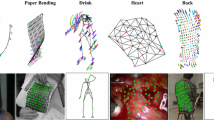Abstract
We present an Expectation-Maximization learning algorithm (E.M.) for estimating the parameters of partially-constrained Bayesian trees. The Bayesian trees considered here consist of an unconstrained subtree and a set of constrained subtrees. In this tree structure, constraints are imposed on some of the parameters of the parametrized conditional distributions, such that all conditional distributions within the same subtree share the same constraint. We propose a learning method that uses the unconstrained subtree to guide the process of discovering a set of relevant constrained substructures. Substructure discovery and constraint enforcement are simultaneously accomplished using an E.M. algorithm. We show how our tree substructure discovery method can be applied to the problem of learning representative pose models from a set of unsegmented video sequences. Our experiments demonstrate the potential of the proposed method for human motion classification.
Preview
Unable to display preview. Download preview PDF.
Similar content being viewed by others
References
Blank, M., Gorelick, L., Shechtman, E., Irani, M., Basri, R.: Actions as space-time shapes. In: ICCV, pp. 1395–1402 (2005)
Burl, M.C., Weber, M., Perona, P.: A probabilistic approach to object recognition using local photometry and global geometry. In: ECCV-II, pp. 628–641 (1998)
Carneiro, G., Lowe, D.: Sparse flexible models of local features. In: ECCV(3), pp. 29–43 (2006)
Crandall, D.J., Huttenlocher, D.P.: Weakly Supervised Learning of Part-Based Spatial Models for Visual Object Recognition. In: Leonardis, A., Bischof, H., Pinz, A. (eds.) ECCV 2006. LNCS, vol. 3951, pp. 16–29. Springer, Heidelberg (2006)
Dempster, A.P., Laird, N.M., Rubin, D.B.: Maximum likelihood from incomplete data via the em algorithm. J. Royal Stat. Soc. 39, 1–38 (1977)
Dollár, P., Rabaud, V., Cottrell, G., Belongie, S.: Behavior recognition via sparse spatio-temporal features. In: VS-PETS (October 2005)
Felzenszwalb, P.F., Huttenlocher, D.P.: Pictorial structures for object recognition. Int. J. Comput. Vision 61(1), 55–79 (2005)
Fergus, R., Perona, P., Zisserman, A.: Weakly supervised scale-invariant learning of models for visual recognition. Int. J. Comput. Vision 71(3), 273–303 (2007)
Filipovych, R., Ribeiro, E.: Combining models of pose and dynamics for human motion recognition. In: ISVC, Lake Tahoe, USA (November 2007)
Fischler, M.A., Elschlager, R.A.: The representation and matching of pictorial structures. IEEE Transactions - Computers 22, 67–92 (1977)
Geiger, D., Heckerman, D.: A characterization of the dirichlet distribution with application to learning bayesian networks. In: UAI, pp. 196–207 (1995)
Jorge, P.M., Abrantes, A.J., Marques, J.S.: Tracking with bayesian networks: extension to arbitrary topologies. In: ICIP (2), pp. 402–405 (2005)
Khan, Z., Balch, T., Dellaert, F.: Mcmc-based particle filtering for tracking a variable number of interacting targets. IEEE Transactions on Pattern Analysis and Machine Intelligence 27(11), 1805–1918 (2005)
Krebs, B., Korn, B., Burkhardt, M.: A task driven 3d object recognition system using bayesian networks. In: ICCV, pp. 527–532 (1998)
Laptev, I., Lindeberg, T.: Space-time interest points. In: ICCV, Nice, France (October 2003)
Niculescu, R.S., Mitchell, T.M., Rao, R.B.: Bayesian network learning with parameter constraints. J. Mach. Learn. Res. 7, 1357–1383 (2006)
Park, S., Aggarwal, J.K.: Semantic-level understanding of human actions and interactions using event hierarchy. In: CVPRW 2004, vol. 1, p. 12 (2004)
Piater, J.H., Grupen, R.A.: Feature learning for recognition with bayesian networks. ICPR 01, 1017 (2000)
Rangarajan, A., Coughlan, J., Yuille, A.L.: A bayesian network framework for relational shape matching. In: ICCV 2003, p. 671 (2003)
Ryoo, M.S., Aggarwal, J.K.: Recognition of composite human activities through context-free grammar based representation. In: CVPR 2006, pp. 1709–1718 (2006)
Author information
Authors and Affiliations
Editor information
Rights and permissions
Copyright information
© 2008 Springer-Verlag Berlin Heidelberg
About this paper
Cite this paper
Filipovych, R., Ribeiro, E. (2008). Discovering Constrained Substructures in Bayesian Trees Using the E.M. Algorithm. In: Campilho, A., Kamel, M. (eds) Image Analysis and Recognition. ICIAR 2008. Lecture Notes in Computer Science, vol 5112. Springer, Berlin, Heidelberg. https://doi.org/10.1007/978-3-540-69812-8_64
Download citation
DOI: https://doi.org/10.1007/978-3-540-69812-8_64
Publisher Name: Springer, Berlin, Heidelberg
Print ISBN: 978-3-540-69811-1
Online ISBN: 978-3-540-69812-8
eBook Packages: Computer ScienceComputer Science (R0)




